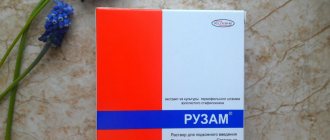Diclofenac is an effective non-hormonal anti-inflammatory drug that is actively used in neurology, rheumatology and traumatology.
Has a large selection of dosage forms. We will discuss further what Diclofenac gel and ointment are used for.
pharmachologic effect
Diclofenac has anti-inflammatory, analgesic and decongestant effects due to inhibition of the synthesis of prostaglandins, which play a major role in the pathogenesis of inflammation. For rheumatic diseases, it reduces pain in the joints at rest and during movement, as well as morning stiffness and swelling of the joints, and helps to increase range of motion. When applied externally, diclofenac penetrates the skin and accumulates in the underlying tissues (subcutaneous tissue, muscle tissue, joint capsule and joint cavity).
Composition and features
Diclofenac is available in several dosage forms. Apply ointment or gel externally.
The substance is diclofenac sodium, its concentration in the ointment is 10 or 20 mg per 1 g, in the gel - 10 or 50 mg per 1 g. Accordingly, the gel can be 1 or 5 percent, and the ointment 1 or 2 percent.
The auxiliary components in the gel are alcohol, propylene glycol, lavender oil, purified water and hyaetellose. The ointment additionally contains propylene glycol, dimethyl sulfoxide and macrogol.
The gel is a homogeneous transparent substance with a slight yellow tint or no color, there is a specific odor, the base is water.
The basic component of the ointment is fat; it has a thicker consistency. Therefore, it is better to use a gel for joints and deep layers of the epidermis. It spreads more easily and dries faster, does not leave stains on clothes and creates a protective film on the skin.
If the skin at the site of application is irritated and prone to peeling, then it is better to use ointment, as it additionally softens and moisturizes the skin at the site of application.
What does “when used correctly” mean? Anointed, and that’s it.
It is advisable to rub in topical forms of NSAIDs for a while rather than just apply them. The analgesic and anti-inflammatory effect of the ointment will be much higher if you do not just “anoint” it, but actively rub the product into the skin over the sore spot for some time. In the course of relevant studies, it was found that even 45 seconds of rubbing diclofenac diethylamine gel five times increased the transdermal delivery of the drug compared to simple application to the skin. And you need to remember that pain-relieving ointments based on NSAIDs act on areas of pain located immediately under the skin. If we talk about joints, then these are the knees, elbows and small joints of the hands. The local form most likely “will not reach the hip joint.” It should be rubbed “around the circumference” of the limb, for example, not only into the dorsum, but also into the palmar surface of the interphalangeal joint [6, 7].
How to use Diclofenac gel
Instructions for use of Diclofenac gel contain detailed information on doses and methods of use of the medicine.
The gel is used only externally in adults and children over 12 years of age according to indications. Apply to the site of inflammation with light rubbing movements 2 or 3 times a day. For one application, 2 g of the drug is enough, which corresponds to a strip of 4 cm.
The maximum permissible dose per day is no more than 6 g. Duration of therapy is no more than two weeks, longer periods are possible in agreement with the attending physician. Be sure to wash your hands after using Diclofenac.
Contraindications and side effects
According to the instructions for Diclofenac ointment, treatment with the drug is contraindicated for:
- high sensitivity to the constituent substances, aspirin or other non-steroidal anti-inflammatory drugs;
- complete or incomplete combination of bronchial asthma with recurrent polyposis of the nose and paranasal sinuses, angioedema or urticaria;
- late pregnancy and lactation;
- treatment of children under 6 years of age;
- open wound surfaces on the skin at the site of application.
Contraindications also apply to the use of the gel, which is prohibited in the treatment of children under 12 years of age.
The drug is prescribed with caution in the early stages of pregnancy, for erosions and ulcers of the stomach and intestines, for chronic dysfunction of the heart and bronchial asthma, severe dysfunction of the liver and kidneys, with a tendency to bleeding, in the treatment of elderly patients.
When applied topically, undesirable reactions may occur:
- rash, burning and redness at the application site;
- urticaria and angioedema with hypersensitivity to the components of the drug;
- with prolonged use, in rare cases, the development of bronchial asthma is possible.
How many times a day and for how long can you apply such drugs?
Typically three to four times a day for two weeks. Topical NSAIDs act quite quickly - the effect occurs within an hour - and help control acute somatic pain of moderate intensity. They cope worse with chronic pain. If there is no effect within two weeks of proper use, you should consult a doctor. There is a chance that he will recommend switching to oral forms or another group of drugs.
Sources
- Derry S, Conaghan P, Da Silva JA, et al. Topical NSAIDs for chronic musculoskeletal pain in adults. Cochrane Database Syst Rev. 2016; 4: CD007400. https://www.cochranelibrary.com/cdsr/doi/10.1002/14651858.CD007400.pub3/full
- Derry S, Wiffen PJ, Kalso EA, et al. Topical analgesics for acute and chronic pain in adults – an overview of Cochrane Reviews. Cochrane Database Syst Rev. 2017; 5: CD008609. https://www.cochranelibrary.com/cdsr/doi/10.1002/14651858.CD008609.pub2/full
- Klinge SA, Sawyer GA. Effectiveness and safety of topical versus oral nonsteroidal anti-inflammatory drugs: a comprehensive review. Phys Sportsmed. May 2013; 41(2): 64–74. https://www.ncbi.nlm.nih.gov/pubmed/23703519
- Kloppenburg M, Kroon FP, Blanco FJ, et al. 2021 update of the EULAR recommendations for the management of hand osteoarthritis Annals of the Rheumatic Diseases 2019; 78: 16–24. https://ard.bmj.com/content/78/1/16
- Honvo G, Leclercq V, Geerinck A, et al. Safety of Topical Non-steroidal Anti-Inflammatory Drugs in Osteoarthritis: Outcomes of a Systematic Review and Meta-Analysis. Drugs Aging. 2019; 36(Suppl 1): 45–64. https://www.ncbi.nlm.nih.gov/pmc/articles/PMC6509095/
- Hasler-Nguyen N, Fotopoulos G. Effect of rubbing on the in vitro skin permeation of diclofenac-diethylamine 1.16% gel. BMC Res Notes. 2012 Jun 21; 5: 321. https://www.ncbi.nlm.nih.gov/pmc/articles/PMC3424122/
- Hagen M, Baker M. Skin penetration and tissue permeation after topical administration of diclofenac. Curr Med Res Opin. 2021 Sep; 33(9):1623–1634. https://www.tandfonline.com/doi/full/10.1080/03007995.2017.1352497
- Rafanan BS Jr, Valdecañas BF, Lim BP, et al. Consensus recommendations for managing osteoarthritic pain with topical NSAIDs in Asia-Pacific. Pain Manag. 2018; 8 (2): 115–128. https://www.futuremedicine.com/doi/10.2217/pmt-2017-0047?url_ver=Z39.88-2003&rfr_id=ori:rid:…
- Pradal J, Vallet CM, Frappin G, Bariguian F, Lombardi MS. Importance of the formulation in the skin delivery of topical diclofenac: not all topical diclofenac formulations are the same. J Pain Res. 2019; 12: 1149–1154. https://www.dovepress.com/importance-of-the-formulation-in-the-skin-delivery-of-topical-diclofen-pee…
- Galer BS. A comparative subjective assessment study of PENNSAID® and Voltaren Gel®, two topical formulations of diclofenac sodium. Pain Pract. 2011; 11 (3): 252–60. https://onlinelibrary.wiley.com/doi/abs/10.1111/j.1533-2500.2010.00420.x
- Tieppo Francio V, Davani S, Towery C, Brown TL. Oral Versus Topical Diclofenac Sodium in the Treatment of Osteoarthritis. J Pain Palliat Care Pharmacother. 2021 Jun; 31 (2): 113–120. https://www.tandfonline.com/doi/abs/10.1080/15360288.2017.1301616?journalCode=ippc20
- Simon LS, Grierson LM, Naseer Z, et al. Efficacy and safety of topical diclofenac containing dimethyl sulfoxide (DMSO) compared with those of topical placebo, DMSO vehicle and oral diclofenac for knee osteoarthritis. Pain. 2009; 143(3):238–45. https://insights.ovid.com/article/00006396-200906000-00016
- Van Amburgh J. Can Topical and Oral NSAIDs Be Combined for Pain Relief? Medscape. https://www.medscape.com/viewarticle/861740
- Roth SH. Nonsteroidal anti-inflammatory drug gastropathy: new avenues for safety. Clin Interv Aging. 2011; 6: 125–31. https://www.ncbi.nlm.nih.gov/pmc/articles/PMC3131982/
- Kowalski ML, Makowska JS, Blanca M, et al. Hypersensitivity to nonsteroidal anti-inflammatory drugs (NSAIDs) – classification, diagnosis and management: review of the EAACI/ENDA and GA2LEN/HANNA. Allergy 2011; 66:818–829. https://www.eaaci.org/attachments/668_Kowalski%20Hypersensitivity%20to%20nonsteroidal%20anti-inflamm…
- Rogers NV, Rowland K. An alternative to oral NSAIDs for acute musculoskeletal injuries. J Fam Pract. Mar 2011; 60 (3): 147–8. https://www.ncbi.nlm.nih.gov/pmc/articles/PMC3183960/
How to use Diclofenac ointment
According to the instructions for use of Diclofenac ointment, the product in a volume of 2-4 g is distributed over the skin at the site of pain, using a slight rubbing motion. It is allowed to use the ointment 2-3 times a day, but the maximum dose should not exceed 8 g.
Children 6-12 years old are allowed to use the ointment no more than twice a day. When determining it, take into account the fact of simultaneous use of diclofenac drugs in other dosage forms (for example, tablets or suppositories).
Duration of therapy is up to 14 days.
Indications for use
Diclofenac ointment and gel are prescribed for the following pathologies of bones and muscles:
- inflammatory and degenerative diseases of articular joints (osteochondrosis, radiculitis, arthrosis, arthritis, including ankylosing spondylitis);
- bruises as a result of injuries;
- rheumatic fever and inflammatory swelling of soft tissues (tenosynovitis, bursitis);
- sprains of tendons, muscles and ligaments, accompanied by an inflammatory response;
- myalgia and arthralgia provoked by heavy physical exertion.
The remedy is intended to eliminate negative symptoms, but does not affect the progression of the disease.
Which topical NSAID is best?
Everything is individual. If the analgesic effect of oral and injectable forms of NSAIDs can be more or less ranked, then an objective comparative assessment of topical drugs is very difficult. The reason for this is that, along with the actual active substance, the intensity of rubbing, excipients (for example, dimethyl sulfoxide) and the placebo effect play a significant role. Most studies on the effectiveness of topical NSAIDs have focused on diclofenac and ketoprofen. The increased attention to them is due to the fact that diclofenac is the only NSAID whose topical forms are approved by the American Food and Drug Administration (FDA), and ketoprofen, accordingly, is approved in most other countries of the world. Reliable data comparing these two drugs with each other have not yet been published. No one questions the effectiveness of other non-steroidal anti-inflammatory drugs for external use (ibuprofen, phenylbutazone, piroxicam, nimesulide, etc.); each of them was the subject of several clinical trials at one time, but the geography of their use is much more modest and is often limited to a few developing countries [2, 8].
Can the product be used by pregnant women and children?
Pregnancy, especially the third trimester, is a contraindication to the use of Diclofenac. If treatment with the drug is necessary in the first half of pregnancy, the doctor is obliged to evaluate all the negative consequences for the fetus and the expected benefits for the woman.
The ability of the drug to pass into breast milk has not been studied, so treatment is not advisable during breastfeeding. If there are serious reasons to use a gel or ointment during lactation, do not apply the substance to large areas of the skin and do not treat it for a long time.
In pediatric practice, it is used in the treatment of children only from 12 years of age.










![Rice. 1. Distribution of NSAIDs according to the degree of selectivity for COX-1 and COX-2 (Warner et al. FASEB J. 2004,18: 790–804 [27])](https://irknotary.ru/wp-content/uploads/ris-1-raspredelenie-npvp-po-stepeni-selektivnosti-v-otnoshenii-cog-330x140.jpg)